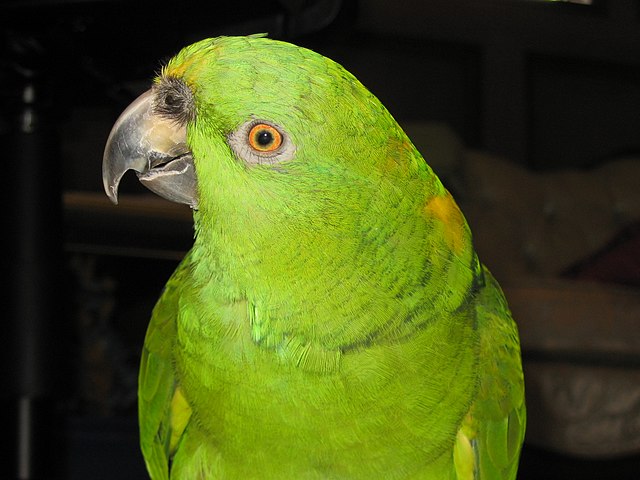Amazona auropalliata, the Yellow Naped Amazon, Genus Amazona, family Psittacidae, is native to the Pacific coast from southern Mexico south to northern Costa Rica.
The plumage is green at the forehead and crown with a yellow band across the lower nape and hind neck. The bill is dark grey fading towards the base of the upper mandible. They are generally lighter and brighter colored than other Amazons. The Yellow Naped Amazon grows to a length of approximately 14-15 inches and weighs 480-550 grams.
In the wild, they eat fruits, seeds, nuts, berries, blossoms, and leaf buds. In captivity, they thrive on a pellet-based diet, daily fresh fruits, and vegetables, with seeds and nuts for treats.

Like most Amazon parrots, the Yellow Naped has a tendency to become overweight. If kept on a healthy diet of pellets, fruits, and veggies, and not allowed to gorge on nuts and seeds, obesity shouldn’t be an issue. While they’re generally extremely hardy, they are susceptible to vitamin-A and calcium deficiencies as well as psittacosis and pox-virus infections.
The Yellow Crowned Amazon is also susceptible to respiratory infections, which means quality nutrition is vital to keep them healthy. The average lifespan in captivity is 50-60 years. During the breeding season, April to May, the female generally lays three eggs. The eggs incubate for 26-28 days and hatchlings are independent 3 months after hatching. Amazon parrots form lifelong monogamous pair bonds.
The Yellow Naped Amazon is famous for being an excellent companion bird. They’re intelligent. They are considered to be good talkers having the ability to learn several words and mimic household sounds. They’re social. They’re affectionate. The Yellow Naped is also an excellent singer and you will often find them singing. Typical of most Amazons and parrots in general, the Yellow Naped Amazon is a noisy bird. Behavior problems often include screaming and can include biting or feather plucking.
The majority of behavior problems can be resolved by providing an optimal environment and by training and proper socialization. Aggression, yelling, throwing water, and other negative reinforcement techniques do not work to resolve behavior issues and only serve to further compound the problem. Positive reinforcement and training are the owner’s best solutions.
Behavior problems are generally mild or non-existent which has made the Yellow Naped Amazon one of the most popular companion birds around the world. This popularity has led to them being listed on the Endangered Species list. Deforestation has also contributed to their demise. It is illegal to import Yellow Naped Amazon. Yellow Naped Amazons form a strong bond with their families. They’re social birds and in the wild, they live in groups ranging from several pair bonds to hundreds of pair bonds.
In captivity, the household will become their flock and Yellow Naped Amazons will demand attention and affection from their ‘flock.’ Fondly called, ‘little humans,’ they love to play with their families, though their favorite pastime may be climbing. They are also known to be excellent flyers. It is advised to keep windows and doors closed when they’re roaming the house. They require a significant amount of time out of their cage each day. When the owners are not home, the Yellow-Naped can be kept busy and engaged with a variety of toys in their cage. Good toys include chewing toys, toys to climb on, and toys that engage their reasoning and puzzle-solving abilities.
